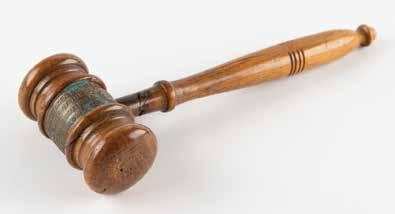
11 minute read
Military
324. USS Constitution 1927 Renovation
Wood Gavel. Gavel constructed of wood removed from the hull of the USS Constitution during the frigate’s historic 1927 restoration, measuring 10˝ long with a cylindrical 3.25˝ x 2˝ head, with the original bronze plate reading: “This material was taken from the original hull of the U.S. Frigate Constitution, Keel laid 1794, Rebuilding 1927.” In fine condition, with some verdigris to the plate. A desirable and uncommon souvenir format from the historic 1927 renovation. Starting Bid $200
Choice twice-signed letter regarding a West Point professorship

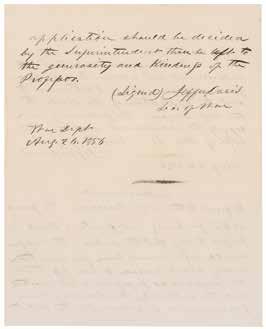
325. Jefferson Davis Autograph Letter Signed Twice. Bold ALS signed twice, “Jeffer. Davis,” one page both sides, 7.75 x 9.75, August 26, 1856. Letter to John W. French, in part: “For the reasons set forth in the endorsement and a desire to save you from any annoyance I determined to send the application of Mr. Sprole to the Engt. bureau. The following is a copy of the endorsement made on the letter of Mr. S.” Signed below by Davis, who goes on to pen a copy of his endorsement: “The period asked for being indefinite I think it proper to say that the duties of the Professor would not permit him for more than a very short period to have less than the undivided possession of his quarters, and the interest of the Academy being paramount it is deemed better that the application should be decided by the Superintendent than be left to the generosity and kindness of the Professor.” This is also signed at the conclusion. In fine condition. Starting Bid $200
Remarkable West Point diploma awarded in 1854, signed by Lee and Garnett
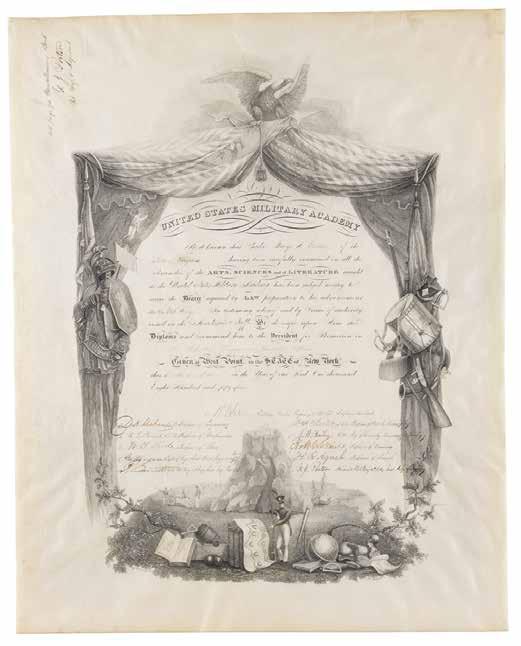
326. Robert E. Lee Document Signed. Beautifully
engraved partly-printed vellum DS, signed “R. E. Lee,” as superintendent of West Point, one page, 17 x 21.5, June 16, 1854. United States Military Academy diploma presented to George A. Gordon “having been carefully examined on all the Branches of the Arts, Sciences, and Literature taught at the United States Military Academy has been judged worthy to receive the Degree required by Law preparatory to his advancement in the U. S. Army…and recommend him to the president for promotion in the Infantry, Dragoons, or Mounted Riflemen.” Signed at the conclusion by Robert E. Lee as superintendent of the Academy, and also signed underneath by 10 professors, including Robert Selden Garnett, Fitz John Porter, A. E. Church, George W. Cullum, J. W. Bailey, and William Bartlett. In fine condition.
After distinguishing himself in the Mexican-American War, Lee reluctantly accepted an appointment as superintendent of the Military Academy at West Point in 1852, where he remained for three years. In addition to Lee’s ever-desirable signature, the extremely rare Robert Selden Garnett, who signed here as a tactics instructor, is a prize in itself—Garnett would become the first general officer killed in the Civil War. Starting Bid $1000
Lee orders a saddle months prior to quelling John Brown’s insurrection
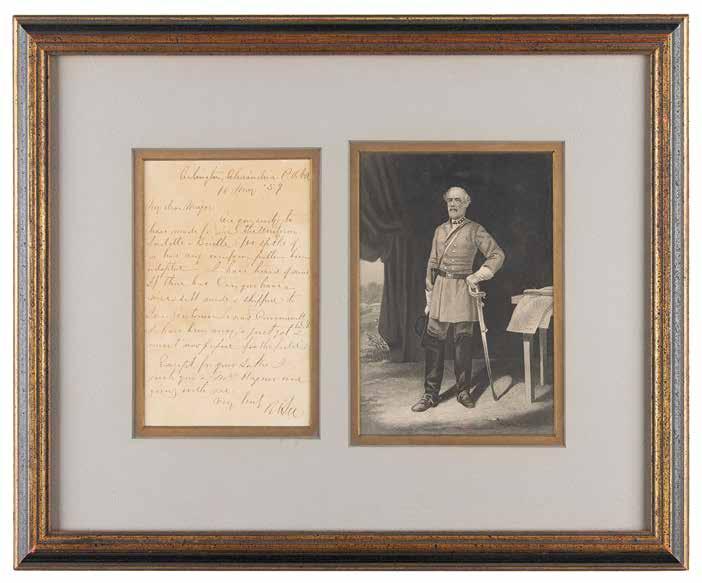
327. Robert E. Lee Autograph Letter Signed. ALS
signed “R. E. Lee,” one page, 4.75 x 7.25, May 10, 1859. Addressed from Arlington in Alexandria County, Virginia, a handwritten letter to Major P. V. Hagner, in full: “Are you ready to have made for me the uniform saddle & bridle I’ve spoke of or has any uniform pattern been adopted—I have heard of none. If there has, can you have a nice sett made & shipped to San Antonio conveniently. I have been away & just got back & must now prepare for the field. Except for your sakes I wish you & Mrs. Hagner were going with me.” Attractively double-matted and framed with an engraving to an overall size of 19.25 x 15.25. In very good to fine condition, with light staining not at all affecting readability. In 1859, before returning to the 2nd Cavalry Regiment in Texas, Lee was called to command the militia raid on abolitionist John Brown at Harper’s Ferry. After returning to his post in San Antonio, Texas seceded from the Union in February 1861, after which Lee returned to Washington and was promoted to colonel and offered the rank of major general in the fight against the seceding states. Though opposed to secession, Lee’s fidelity to Virginia outweighed his loyalty to the Union, and in April 1861, he accepted command of Virginia’s Confederate forces, eventually becoming its general-in-chief. Starting Bid $300
As president of Washington College, Lee learns that he has been appointed to “the Committee on ‘School Discipline’”
328. Robert E. Lee Autograph Letter
Signed. ALS signed “R. E. Lee,” one page both sides, 5 x 8, May 15, 1867. Addressed to Professor Socrates Maupin, a handwritten letter from Robert E. Lee as president of Washington College in Lexington, Virginia, in part: “I have been informed by the…Educational Association of VA that you, Genl Smith, & myself were appointed at their last meeting the Committee on ‘School Discipline.’ In the uncertainty of what was desired, upon consultation with Genl Smith, the accomp paper has been prepared, which is submitted to you for such suggestions, alterations, or substitution, as you may think best; & I beg that you will exercise the fullest latitude of judgment in the matter. Genl Smith is now absent. I have thought it prudent to attach my signature to the report even in its unfinished state. When prepared for presentation the signatures of the whole committee can be affixed. With my kindest regards to yourself & all your Faculty.” In fine condition. Starting Bid $300


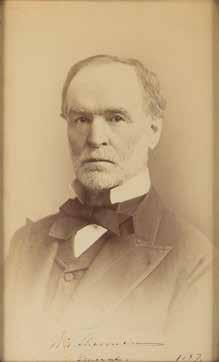
Amazing, uncommonly large portrait of General Sherman from 1887
329. William T. Sherman Signed Photograph. Tremendous 7 x 11.5 imperial
bust portrait of William Tecumseh Sherman in a suit and bow tie, originally taken by Falk Studios of New York, signed in the lower portion of the image in black ink, “W. T. Sherman, General 1887.” Framed and in fine condition, with minor ink adhesion issues, and scattered tiny foxing to the lower half of the image.As the owner of Falk Studios, Benjamin ‘Jake’ Falk was the most reputable theatrical portraitist working in New York at the turn of the 20th century. The photographer used artificial light sources to create portraits considered to be the most dramatic images available. At the time Sherman signed this portrait, the former general had only been retired from army life for three years, was living in New York City, and was undoubtedly familiar with Falk and his work. It is likely that this image was signed during one of Sherman’s many visits to the New York theater scene, or via his role as a colorful speaker at one of the numerous dinners and banquets to which he had been invited. Starting Bid $200
Custer appoints a corporal in the 7th Cavalry—the recoverer of the only Little Bighorn battle flag

330. George A. Custer Document Signed. Partly-
printed vellum DS, signed “G. A. Custer,” one page, 15.5 x 9.75, April 19, 1875. As commander of the 7th Cavalry at Fort Abraham Lincoln in the Dakota Territory, Lt. Col. Custer appoints Ferdinand A. Culbertson as a “Corporal in Company A of the Seventh Regiment of Cavalry in the service of the United States.” Signed at the conclusion by Custer and countersigned by W. W. Cooke. In very good to fine condition, with small holes along the central vertical fold, and Custer’s signature very light but fully legible. The countersignature by William Winer Cooke adds greatly to this document: Cooke, a member of the so-called ‘Custer Gang,’ was one of the commander’s most loyal men and remained so until the end, found by Custer’s side on the fields at Little Bighorn in 1876. The appointee, Ferdinand A. Culbertson, was still serving in the 7th Cavalry’s Company A during the Battle of the Little Bighorn and did not participate in the massacre. He is remembered for recovering the famed ‘Culbertson Guidon’ three days after the fight while part of a burial detail tasked with interring the dead American soldiers. Starting Bid $1000
‘I came through and I shall return’— MacArthur, a man of his word, returns to the Philippines in October 1944

332. Douglas MacArthur Signed Photograph. Vintage
matte-finish 10 x 8 U.S. Army photograph of General MacArthur wading ashore Leyte Island in the Philippines in October 1944, signed neatly over his person in fountain pen. Reverse bears U.S. Army photo credit stamp, numbered “CC 349595.” In fine condition, with light creasing to the lower right corner. General Douglas MacArthur had been forced to evacuate the island of Corregidor in the Philippines in advance of encroaching Japanese forces in March 1942. Transported by PT-boat and fighter planes to southern Australia, the commander had made an impassioned speech at the Terowie railway station on March 20, declaring, ‘I came through and I shall return.’ MacArthur did return to the Philippines in the fall of 1944. The General, who had been observing military actions from the cruiser U.S.S. Nashville moored in Leyte Gulf, took a landing craft towards the beach on the afternoon of October 20, 1944. The water was too shallow to bring the party completely ashore, so MacArthur, accompanied by an entourage of American and Philippine brass, waded through the 50 yards of silty water to the beach. Starting Bid $500
Pray for peace, prepare for war— General Patton on combat, its history and cause, and how a powerful America remains “the one hope for a peaceful world”
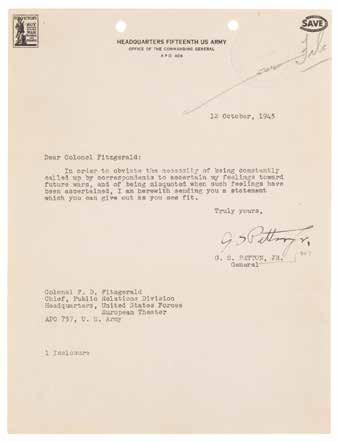

333. George S. Patton Typed Manuscript Signed with Accompanying Typed Letter Signed. Significant
typed manuscript by George S. Patton, signed “G. S. Patton, Jr.,” two pages, 8 x 10.5, sent by General Patton to Colonel F. D. Fitzgerald, chief of the Public Relations Division at the United States Forces headquarters, on October 12, 1945, six weeks after the unconditional surrender of Japan aboard the USS Missouri, an event that officially ended World War II. The compelling two-page statement consists of Patton’s opinion of warfare, why it occurs, why it’s necessary, and how future bloodshed can be prevented. The manuscript is accompanied by a typed cover letter, also signed by Patton, written on his personal Headquarters Fifteenth US Army letterhead. It reads: “In order to obviate the necessity of being constantly called up by correspondents to ascertain my feelings toward future wars, and of being misquoted when such feelings have been ascertained, I am herewith sending you a statement which you can give out as you see fit.” Patton’s statement, in part: “Wars are not the result of a set of logical circumstances. Almost invariably wars are produced through the efforts of a few unbalanced people who play on the many by exploiting thwarted ambitions and the emotions of avarice or revenge…My thesis is that had we been prepared, several of the wars we have engaged in would not have happened and all of them would have been much shorter and less bloody. I have studied and practised war all my life. Therefore I am utterly opposed to it but I am not an ostrich. I do not bury my head in the sands of wishful thinking. I am firmly convinced that we must have universal training because the one hope for a peaceful world is a powerful America and the only means of producing a powerful America is to initiate and maintain adequate means to instantly check aggressors. Unless we are so armed and prepared the next war will probably destroy us. No one who has lived in a destroyed country can view such a possibility with anything but horror.” In fine condition. Starting Bid $1000
Nelson supports the Austrian advance against Bonaparte: “Our enemies should be convinced of the most perfect harmony subsisting between the Allies”
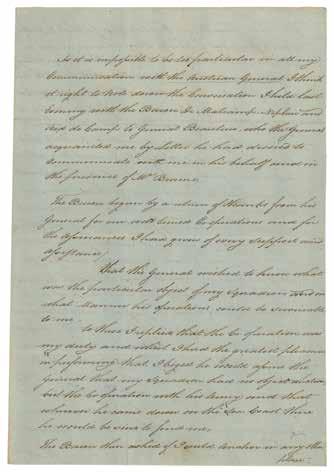
334. Horatio Nelson Letter Signed. LS, four pages
on two adjoining sheets, 8.25 x 12, no date but circa August 1795. Lengthy report in which Nelson, anchored near Genoa in support of the Austrian advance against Napoleon’s forces on the mainland, discusses his immediate plans. He has had a conversation with the Baron de Malcamp, nephew and aidede-camp to the Austrian general, Beaulieu: “I begged he would assure the General that my squadron had no object whatever but the co-operation with his army, and that wherever he came down on the sea coast…he would be sure to find me…Vado was the only place where our fleet could lay in safety, but as for my squadron all places would suit it…I had understood St. Giacomo was strongly fortified, and if 6 or 7000 men were to be lost in getting it merely for the immediate possession of Vado Bay it was no object for us if the General chose to leave them to the eastward.”
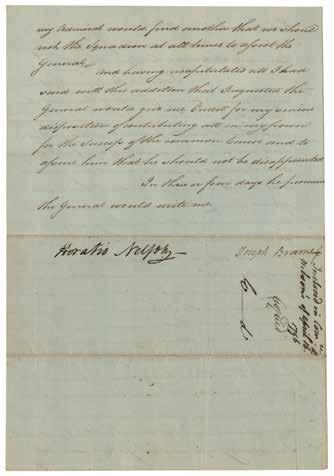
The Baron assured Nelson that “the General would send me a tableaux of his plan of operations, that the General desired… [that] the most perfect harmony would be kept up with me, and that from my character as well as from my exactness…he was assured all would go well for the common cause…[and] that our enemies should be convinced of the most perfect harmony subsisting between the Allies.” Neatly and boldly signed at the conclusion by Nelson. In fine condition, with intersecting folds and light creasing. Starting Bid $300










